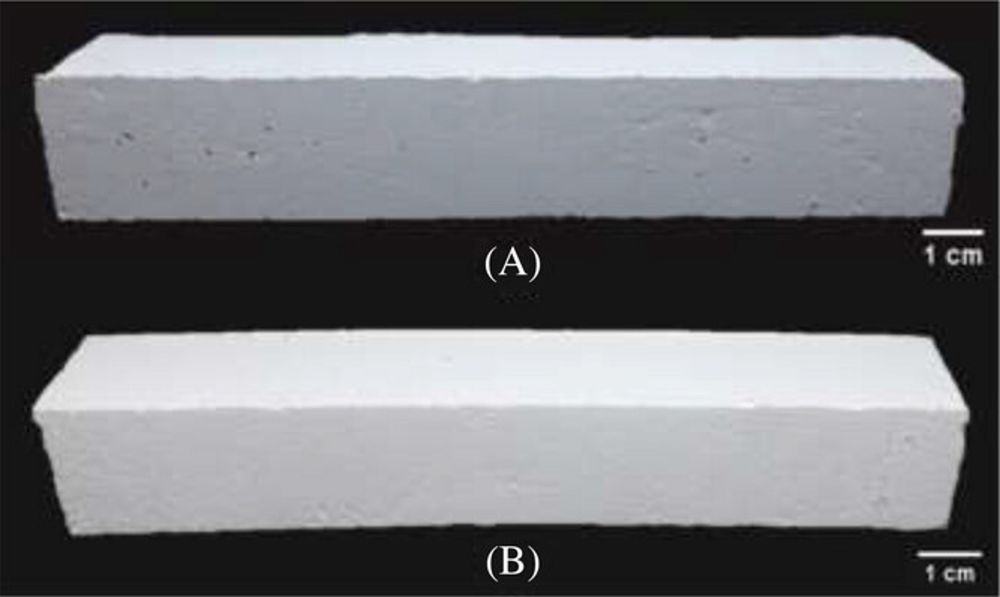
[Image above] Images of the high-alumina geopolymer-bonded refractory samples obtained after (A) curing at 40°C and (B) firing at 1,250°C. Credit: Parente Bezerra et al., International Journal of Applied Ceramic Technology
Cement’s carbon footprint is a topic of much discussion in the construction industry. But it is not the only industry that relies on this material.
The refractories industry also is concerned about carbon emissions from cement production. However, the main cement used in this sector—calcium aluminate cement (CAC)—differs from the well-known Portland cement used in construction.
Unlike Portland cement, which is made by reacting limestone and clay to produce calcium silicates, CAC is made by reacting a lime-containing material with an aluminous material to produce calcium aluminates.
CAC is a rapid-hardening cement, which means CAC-based concrete develops as much strength in 24 hours as Portland-cement-based concrete achieves in 28 days. It also is resistant to high temperatures and corrosive substances. These properties make CAC a great binder for monolithic refractories.
However, CAC-bonded refractories face several drawbacks. Besides carbon emissions, CAC-bonded refractories must undergo a carefully controlled drying process to ensure effective removal of free and/or chemically bound water in the cement. Consequently, the drying process involves high energy consumption and significant financial costs.
Instead of CAC binders, researchers have explored various cement-free organic and inorganic binders. Of these alternatives, a class of inorganic aluminosilicate materials called geopolymers has emerged as a promising option.
Geopolymers consist of well-polymerized nanoparticles ranging in size from 5 to 40 nm. Advantages of using geopolymers as refractory binders include
- Promotes quick setting,
- Reduces the risks of damage and explosions of the ceramic lining compared to CAC,
- Exhibits optimized mechanical behavior at both low and high temperatures, and
- Can be synthesized from industrial waste and by-products at lower temperatures.
Numerous studies have explored the effect of starting material and synthesis procedure on the performance of geopolymer binders. A recent study by researchers at the Federal University of São Carlos in Brazil builds on this history by designing and characterizing three new geopolymer compositions.
The researchers focused on geopolymers derived from metakaolin, a dehydroxylated form of the clay mineral kaolinite. They chose this starting material based on promising results from previous studies here and here, which found metakaolin-based compositions demonstrated exceptional thermal and mechanical stability.
They synthesized the geopolymers by mixing the metakaolin with three different alkaline silicate-containing liquid reagents based on either NaOH, KOH, or a combination of both.
They added alkaline silicates to the liquid reagent because such an addition “has become one of the most widely adopted methods to enhance system reactivity and accelerate geopolymerization reactions,” they explain.
Characterization of the different binders revealed that geopolymers synthesized using the sodium-based liquid reagent demonstrated more desirable properties than the potassium-containing samples. For example,
- Setting time. The sodium-containing geopolymer exhibited a faster setting time (∼11 h) compared to the potassium-containing compositions (∼19 h).
- Mechanical strength. After curing, the potassium-containing compositions displayed lower mechanical strength (25.6 and 31.4 MPa for GP-NaK-CS and GP-K-CS, respectively) than the sodium-containing geopolymer (GP-Na-CS = 50.4 MPa).
Based on these findings, the researchers chose the sodium-containing geopolymer for follow-up experiments.
They fabricated alumina-based castable refractories using either geopolymer or CAC binders. To ensure a fair comparison, the raw material contents in the matrix were normalized so that each castable featured 12 wt.% of binder.
Initially, the geopolymer-bonded castables exhibited a lower mechanical strength than the CAC-bonded castables up to 800°C, likely due to the limited extent of the geopolymerization process.
However, after firing at 1,100°C, the geopolymer-bonded castables showed a significant increase in mechanical strength. They reached a maximum flexural strength of 34.89 MPa and an elastic modulus of 94.22 GPa after firing at 1,250°C. In contrast, the CAC-bonded castables exhibited flexural strength of 22.56 MPa and elastic modulus of 44.01 GPa at that temperature.
Thus, the sodium-containing geopolymer binder demonstrates potential “as an alternative to CAC in the development of novel high-alumina compositions with technical, economic, and sustainable benefits under high-temperature conditions (1,100–1,250°C),” the researchers write.
They conclude the paper by noting that refractory compositions are inherently more complex than the ones investigated in this study, as commercialized refractories incorporate both fine and coarse aggregates.
Therefore, “the adjustment of the geopolymer binder content, in combination with the presence of coarse components, is expected to play a crucial role in controlling the linear dimensional variation and maximum service temperature of the formulated compositions,” they write. They plan to explore these aspects further in a forthcoming paper.
The paper, published in International Journal of Applied Ceramic Technology, is “Design, characterization, and incorporation of geopolymer binders in refractory ceramic compositions” (DOI: 10.1111/ijac.14507).
